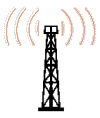
CATEGORIES:
BiologyChemistryConstructionCultureEcologyEconomyElectronicsFinanceGeographyHistoryInformaticsLawMathematicsMechanicsMedicineOtherPedagogyPhilosophyPhysicsPolicyPsychologySociologySportTourism
Broadcast
For longer distances or when cables are not practical, other transmission media come into play. We're getting really high tech here!
It may seem odd to call microwaves, radio waves, or light a "physical" medium. All are electromagnetic in nature. Sometimes they are treated by scientists like streams of teeny, tiny particles and other times like waves on the beach. In their "particle" life, they do behave like a bunch of physical particles. So it's not quite as odd as it first appears. (But all those electromagnetic things are plenty odd!)
| Wireless | (infrared, light, radio) Wi-Fi uses radio waves.
|  Wi-Fi signal logo
Wi-Fi signal logo
| ||||
| Microwave | Uses cell towers. 3G and 4G wireless connections are now common for smartphones but also laptops and tablets.
| 
| ||||
| Satellite |
|
Date: 2015-01-11; view: 1320
| <== previous page | | | next page ==> |
| Computer to Computer: Transmission Media | | | Computer to Computer: Modems |